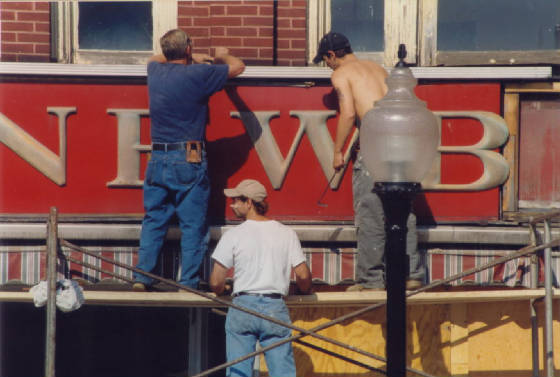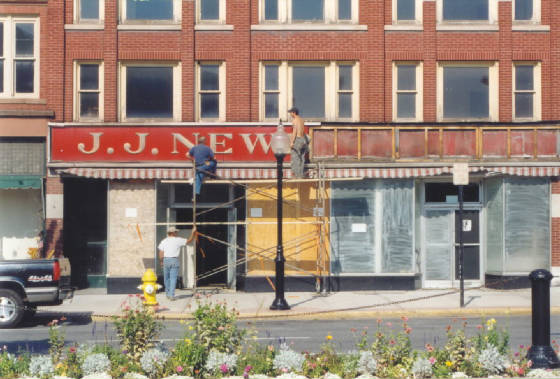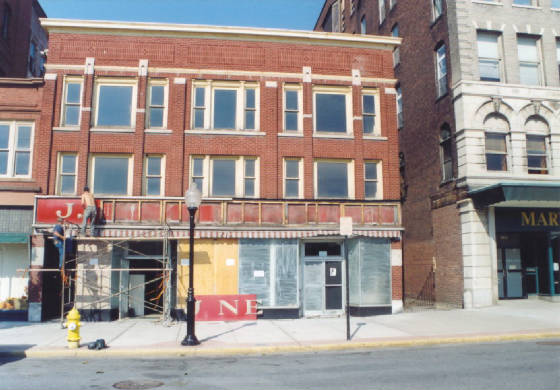|
|
|
|
On Thursday, October 4, I watched with sadness as the familiar J.J. Newberry’s sign was retired. It did not go easily, stubbornly hanging on for a full eight years after the closing of the last five and dime in North Adams.
Almost a month later, as I drove over Route 9 from Florence, the trees were nearly bare in the high elevations of Cummington and Windsor, the remaining leaves painted with deep copper hues that only the angled sunlight from the east could fully reveal. Looking up toward Furnace and Walnut Streets as I headed into the city, I rediscovered houses that had slept cozily under blankets of summer foliage. Now they must endure the winter once again. Life is always changing in this valley of the seasons.
In the past 200 years, the neighborhoods of North Berkshire have sprung up from the arrival of English, Irish, Scottish, German, French-Canadian, Russian, Polish, Slovakian, Italian, Lebanese, Asian, and Hispanic immigrants. Most of these new Americans settled along the river, in the hills, near saw mills, cotton mills, and shoe mills. Only after the harnessing of electricity, the invention of the automobile, and two world wars did they begin to spread out along the highways, where they built modern rectangular houses on the flatlands between mountains, safely distant from the river.
One of those great neighborhoods disappeared under the rubble left by urban renewal in the 1970s. It was the last truly urban neighborhood in North Berkshire. The front yards and back yards of these downtown residents were the asphalt streets and alleyways below their walk-up apartments above stores and restaurants. On their way home from school, children stopped at the Mom & Pop candy store, played marbles and nipsy near the YMCA, and watched the newspapers roll off the presses through a large picture window. This was the Bank Street neighborhood, which included Summer Street and the south side of Main Street.
In Disappearing Into North Adams, Marilyn (Haley) Bourdon recalled growing up there:
“I lived at 36 Bank Street from 1937 until 1958. We had a steam-heated apartment upstairs on the first floor. There were fourteen stairs up to my apartment. I used to take them two at a time. There were six apartments in my apartment house. There were other families that lived there, and many of them lived there for many years. You got to know everyone. We had windows in the front and windows in the back, but no windows in the bedrooms. We had a back porch where my mother would do her wash and hang it up. We called our back porch the piazza. I could look out the front window of my apartment and see the train depot and the trains coming.”
“I went to Mark Hopkins School. In those days, you came home for lunch, so I walked one way or the other four times a day. Every day, when I headed back to school from lunch, my mother would give me a nickel, and I would to stop at Nassif’s Drug Store.”
“In the old days, when we had elections, the North Adams Transcript would have the results posted on their windows. I had a friend named Joan Russell. Her dad was a printer for the paper. We used to go there after school and look down through the windows and watch her dad working on the press. He’d wave at us.”
“As a little kid, I spent all my time on roller skates. Bank Street was flat at the beginning, and then it went uphill. That was the best street to roller skate on. At the top of Bank Street by Summer Street, it was a real wide corner. We used to jump rope there, and customers would be going in and out of the stores all the time. We’d be singing our songs like, ‘Lady, lady, touch the ground.’ They never bothered us or told us to leave.”
“We didn’t have a backyard to play in. We played right in the street. There were so many doorways and alleys on Bank and Summer, so we liked to play hide and seek. The alleys were spooky. I spent most of my time at the YMCA. The Y was so good about letting us kids play in their dirt yard in front. We would jump rope and play hopscotch. We played baseball in the parking lot behind Bateman’s City Market.”
“I wish I had gone to see it when they tore down Bank Street. Maybe I could have taken a brick or something. I was so busy raising my own family that I didn’t think about it. When I finally realized what had happened, I was astounded. My sister’s son came to visit about a year ago, and we took him out to dinner. He said to me, ‘Where did you live?’ We drove him to the Kmart parking lot and pulled up to the spot where our apartment had been. I said to him, ‘I think you’re sitting on my bed.’”
Several days ago, I drove over early in the morning and stood at the spot where cars used to enter Bank Street from Main Street. Newberry’s was sporting a new, 21st-century red sign, minus the letters. What kind of 21st-century store will replace it? One more change in this valley of the seasons.
Final Autumn, poem by Joe Manning
The gold letters,
faded as the fallen leaves of a Halloween oak,
And the red sign,
darkly brilliant as a Columbus Day maple,
Are carefully removed
from the weary facade of another time,
In this final autumn
of the five and dime.
|
|
|
|



